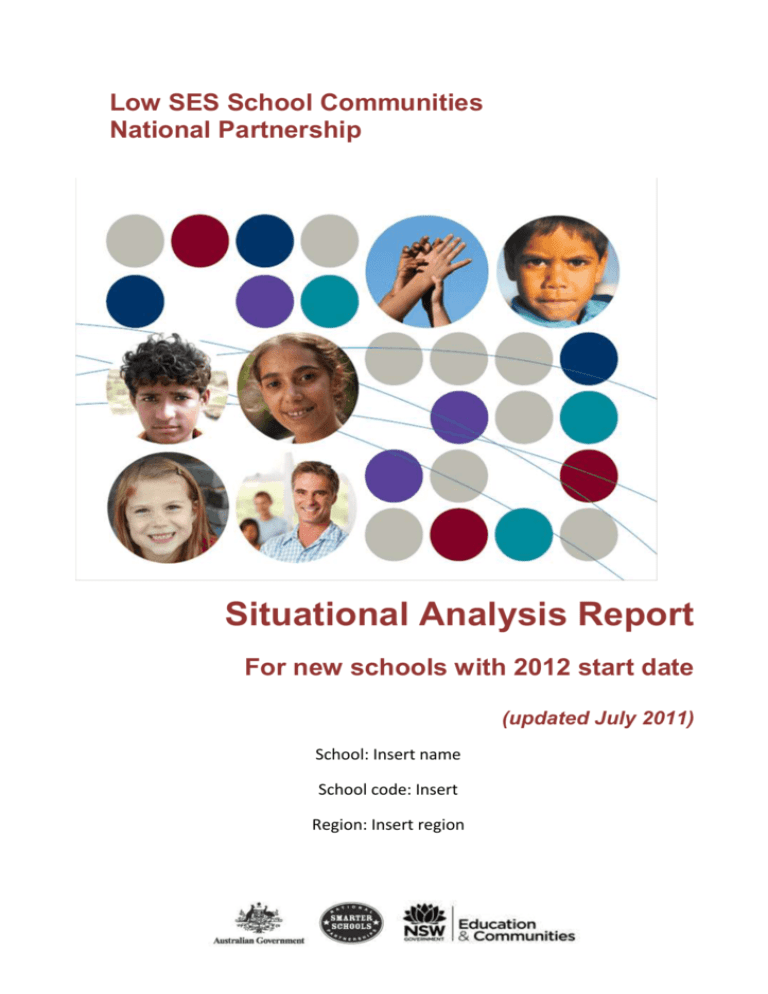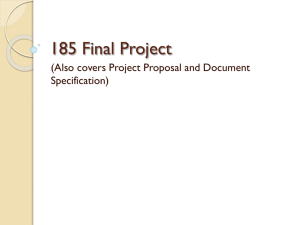Situational Analysis Report Template 2012
advertisement

Low SES School Communities National Partnership Situational Analysis Report For new schools with 2012 start date (updated July 2011) School: Insert name School code: Insert Region: Insert region Situational Analysis Report The following is a report prepared as a result of a Situational Analysis at Insert school name from Insert dates. School Situational Analysis team members: names and positions Insert names and positions Report authors: names and positions Insert names and positions I endorse the contents of this report. Insert Principal's Name Principal Insert name of School A copy of this report has been lodged with the School Education Director with responsibility for this school. XXXXX School, Low SES School Communities National Partnership School Situational Analysis, for schools beginning 2012 Page 2 of 10 Table of contents 1. School context............................................................................................................4 2. Methodology...............................................................................................................4 3. Findings......................................................................................................................6 4. Conclusions and recommendations...........................................................................8 5. School plan targets 2012...........................................................................................9 6. Strategies 2012 - funded by the Low SES School Communities National Partnership...............................................................................................................10 XXXXX School, Low SES School Communities National Partnership School Situational Analysis, for schools beginning 2012 Page 3 of 10 1.0 SCHOOL CONTEXT Insert description of school context from the current School Plan. 2.0 METHODOLOGY In conducting this school Situational Analysis, the following phases were followed to draw conclusions, make recommendations and develop strategies linked to the six Reforms of the Low SES School Communities National Partnership: 1. planning the process 2. collecting data 3. analysing data 4. communicating findings, recommendations and strategies. Insert details in the table below [This section outlines the tasks undertaken to complete the Situational Analysis including dates for key activities and tools utilised for collecting and analysing data. A list of data sources is included in Appendix 2 of the Low SES School Communities National Partnership Information package for schools, but schools may wish to include other sources of data to reflect their local or regional context.] Delete this italicised section from the final report. Timeline for the situational analysis Date/s Phase Task/s Planning the process Establish a Situational Analysis team including representatives from key stakeholder groups Principal Determine the data that needs to be collected and the tools available Develop a timeline for the Situational Analysis, including tasks, required resources and allocation of personnel responsible Principal and Situational Analysis team Decide how the findings will be communicated to the school community. Undertake a SMART training workshop. Collecting data Required resource Staff responsible Collect data on: XXXXX School, Low SES School Communities National Partnership School Situational Analysis, for schools beginning 2012 Page 4 of 10 Date/s Phase Task/s Required resource Staff responsible Situational Analysis report template Principal and Situational Analysis team o student enrolment o student attendance o student retention o student literacy/numeracy performance o staff profile o student engagement o parents/community o (comprehensive community involvement including Aboriginal community and AECG) Analysing data Scanning the data Drawing conclusions Validating the conclusions Explaining significance of conclusions. Communicating findings, recommendations and strategies Communicate the findings, explaining conclusions, making recommendations and developing strategies linked to Reforms. Insert additional rows as required XXXXX School, Low SES School Communities National Partnership School Situational Analysis, for schools beginning 2012 Page 5 of 10 3.0 FINDINGS [Use the following questions as prompts to discuss the findings from your school’s data. Enter your findings into the relevant sections below. Delete this text and the questions from your final report.] Student enrolment Are enrolments increasing, decreasing or remaining static? Are there particular reasons for enrolment being at these levels? Student attendance Are attendance rates increasing, decreasing or remaining static? Are attendance rates above, below, or consistent with state/region? What are we doing to improve attendance rates? Student retention (central/secondary schools) Are retention rates increasing, decreasing or remaining static? How do they compare to state, region and SEG measures? Student performance (primary/central schools) What does the Best Start Kindergarten Assessment data indicate about the literacy and numeracy levels of students beginning school? What are the implications for our planning for K-2 students? Student performance (all schools) How were the students represented across the bottom 2 and proficient (top 2) bands in NAPLAN? What comparisons to LSG and state could be made? How did the growth rates for the various aspects compare with state growth rates? What are the overall areas of strength and those for further development? What spread of students were represented across the bands? Is this significantly different from previous years? What does the value-added data indicate for: lower, middle and higher performing students? Is this significantly different from previous years? Student performance (central/secondary schools) How many students are choosing Vocational Education pathways? Is this an increasing/decreasing trend? How many students Years 10-12 have completed an AQF Certificate 11 level qualification in 2008/09 or completed Year 12? Is this an increasing/decreasing trend? XXXXX School, Low SES School Communities National Partnership School Situational Analysis, for schools beginning 2012 Page 6 of 10 Student engagement What findings did the surveys generate on student attitudes and learning experiences in literacy and numeracy to inform school planning? Staff profile What percentage of various funding dissections supported staff professional learning? Are there implications for areas of professional learning that could be enhanced? What were our targets for 2009/10 and did our professional learning funds build staff capacity to help us achieve our targets? What findings did the surveys generate on teacher confidence, beliefs and perceptions in the teaching of literacy/numeracy to inform school planning? Parents/community Are there implications for cohorts of students on attitudes and engagement? Are there implications for improving parent satisfaction with aspects of school operation? Are there implications on the level of home, school and community partnerships? XXXXX School, Low SES School Communities National Partnership School Situational Analysis, for schools beginning 2012 Page 7 of 10 4.0 CONCLUSIONS AND RECOMMENDATIONS Using the findings from Section 3, develop conclusions, recommendations and strategies linked to the six Reforms. Conclusion Recommendation Draft strategies to be implemented A number of outcomes were identified in the NAPLAN data as being problematic Identify outcomes where students have performed above/below state average Whole school analysis of NAPLAN using SMART to identify strengths and weaknesses with alignment to syllabus outcomes Example only – delete from final report Identify teaching and learning strategies to improve outcomes of higher/lower achieving students Final strategies to be implemented (following joint planning sessions) NP Reform Incorporate teaching strategies from SMART data for identified outcomes into teaching and learning programs XXXXX School, Low SES NP School Situational Analysis, July 2010 version Page 8 of 10 5.0 SCHOOL PLAN TARGETS 2012 In this section schools should insert the 2012 School Plan targets based on the Situational Analysis report. Targets 2012 Example 1: Increase the number of students (in years 7 and 9) achieving at or above minimum standard from 89% in 2010 to 92% in 2011 in NAPLAN Literacy. Insert additional rows as required XXXXX School, Low SES NP School Situational Analysis, July 2010 version Page 9 of 10 6.0 STRATEGIES 2012 - FUNDED BY LOW SES SCHOOL COMMUNITIES NATIONAL PARTNERSHIP In this section schools should indicate the school’s key strategies for 2012. Include strategies that may be co-funded from both Low SES and other funding sources Key strategy 2011 Example: Teacher professional learning in explicit and systematic teaching of literacy. Insert additional rows as required XXXXX School, Low SES NP School Situational Analysis, July 2010 version Page 10 of 10



